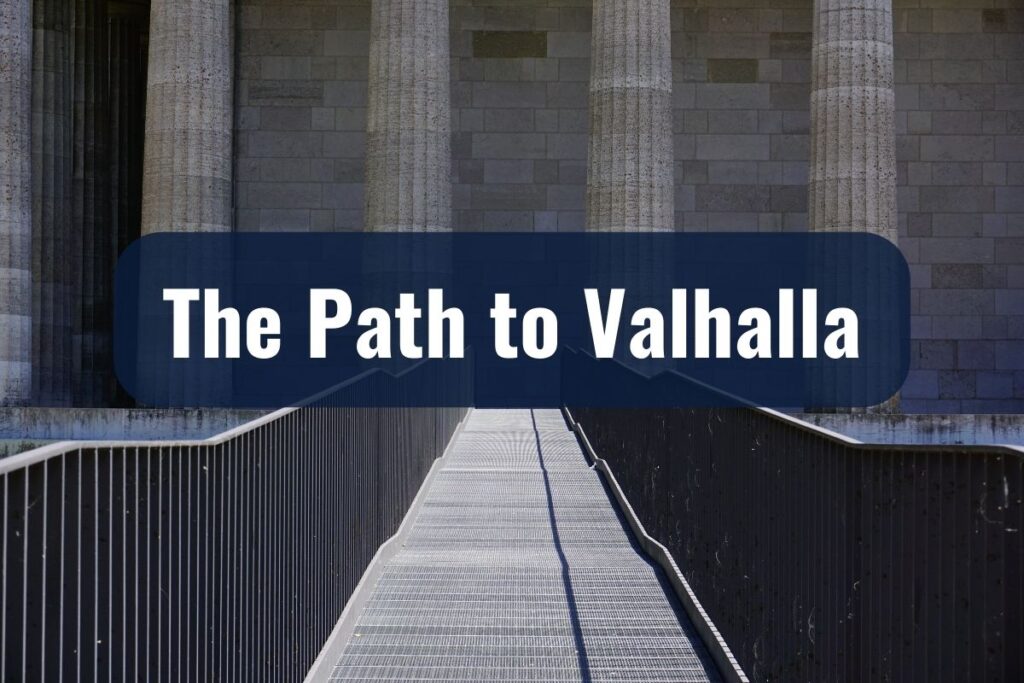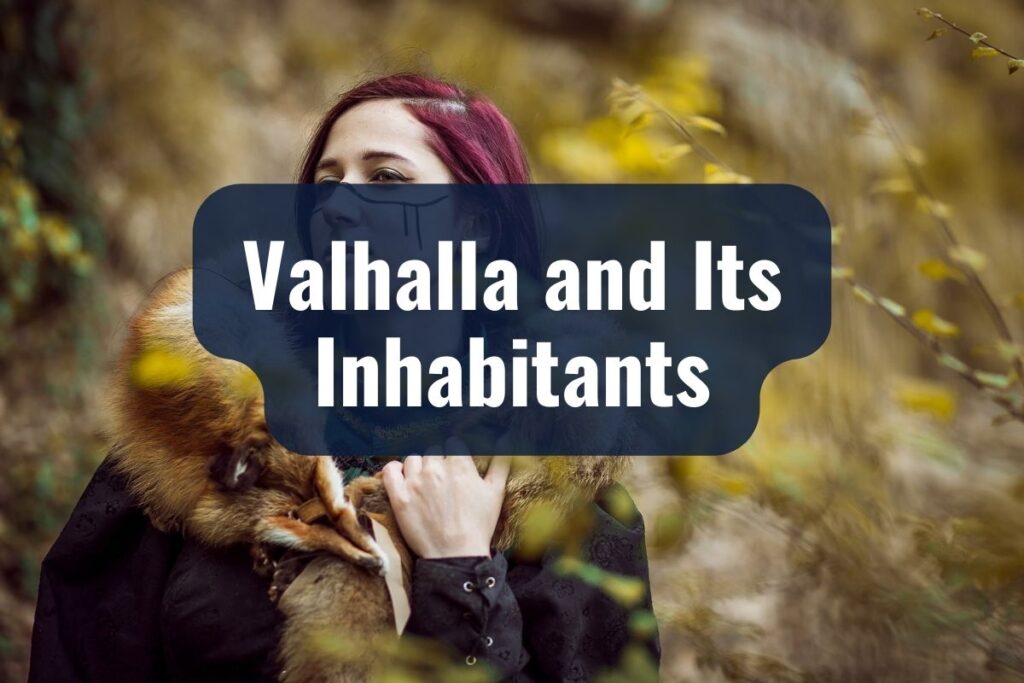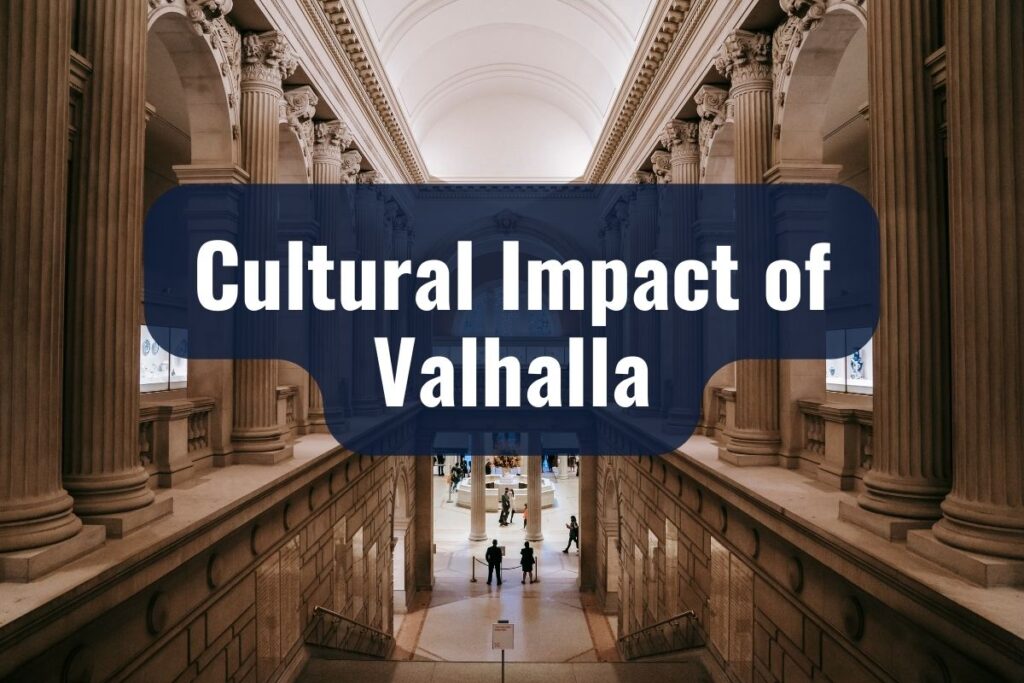In the verdant lands of Scandinavia, long before the modern era, a vibrant tapestry of myths and legends wove the fabric of what we today know as Norse mythology. These ancient stories, passed down through generations, paint a picture of a world filled with gods, giants, and an array of mystical beings. Among these tales, one concept stands tall, capturing the imagination of many: Valhalla.
Valhalla, in Norse mythology, is not just a place; it is a symbol of honor, glory, and eternal life in the afterworld for the bravest of warriors. It is here, in this majestic hall, that the souls of warriors who died in combat find their final resting place, as chosen by Odin, the Allfather and chief deity in the Norse pantheon. Valhalla represents the ultimate reward for those who lived a life of valor and bravery, embodying the virtues most revered in Viking culture.
In this exploration, we delve deep into the heart of these ancient Norse beliefs, unraveling what is Valhalla. Through our journey, we will discover not just the details of this mythical hall, but also its significance in Norse cosmology, its impact on Viking society, and its enduring legacy in modern culture. Join us as we step into the world of Norse gods and heroes, uncovering the secrets of Valhalla.
Key Takeaways
- Valhalla is a grand hall in Norse mythology, symbolizing honor and glory for fallen warriors.
- Entry into Valhalla is reserved for warriors who die heroically in battle, chosen by Valkyries.
- Life in Valhalla involves endless feasting, training for Ragnarök, and camaraderie among Einherjar.
- Valhalla is ruled by Odin and inhabited by gods and legendary heroes, reflecting Norse values.
- Situated in Asgard, Valhalla is central in Norse cosmology, connected to other realms via Yggdrasil.
- Valhalla has significantly influenced Viking culture, modern literature, art, and media.
What is Valhalla?
A Hall of Eternal Glory
In the mystical realm of Norse mythology, Valhalla stands as a majestic and grand hall, presided over by Odin, the Allfather. Its very name, derived from Old Norse words ‘Valhöll’, translates to ‘the hall of the slain’, evoking images of heroism and eternal honor. This grand hall is not just a dwelling; it’s a symbol of ultimate recognition and valor for those who have proven themselves in battle.
Valhalla in Norse Myths
As depicted in the sagas and poems of old, Valhalla is an awe-inspiring place, with its walls wrought from the spears of warriors, its roof thatched with golden shields, and its benches adorned with fine mailcoats. This architectural marvel reflects the spirit of the Viking age – a testament to bravery, strength, and the pursuit of glory. It is said that the hall is so vast that it is beyond the comprehension of mortal minds, embodying the grandeur and magnificence of the gods themselves.
The Role of Valhalla in the Lives of Gods and Warriors
Valhalla serves a crucial purpose in Norse cosmology. It is not only a final abode for the valorous dead but also the training ground for the ultimate battle of Ragnarök. Here, the chosen warriors, known as Einherjar, spend their days in rigorous combat training and their evenings in joyful feasting and camaraderie, preparing for the day they will fight alongside the gods. In this way, Valhalla is intertwined with the Norse concept of destiny and the cyclical nature of time and existence.
Symbolism and Significance
The concept of Valhalla extends beyond the physical description of a hall; it is a symbol of the Norse understanding of death and the afterlife. For a Viking warrior, being chosen to reside in Valhalla was the highest honor, signifying a life well-lived, marked by bravery and honor. This belief system provided a powerful moral framework and an incentive for warriors to strive for greatness, courage, and nobility in their lives.
The Path to Valhalla

The Criteria for Entering the Hallowed Halls
The journey to Valhalla, the revered hall of the slain, is reserved for a select few. In Norse mythology, not every warrior is granted access to this prestigious afterlife. The primary criterion for entry is a heroic death in battle, a testament to bravery and valor. This death is not just a physical end but a doorway to eternal glory, a transition from mortal life to an everlasting existence among the gods and legendary heroes.
The Valkyries: Choosers of the Slain
Central to the process of selecting who enters Valhalla are the Valkyries, divine shieldmaidens who serve Odin. These powerful beings ride over the battlefields, observing the chaos of war with a discerning eye. They are tasked with a sacred duty: to choose the bravest of the fallen warriors and guide their souls, known as the Einherjar, to Valhalla.
The presence of Valkyries on the battlefield is a sign of Odin’s interest, and being chosen by them is a great honor, symbolizing a warrior’s courage and prowess in battle.
The Soul’s Journey to the Hall of Heroes
Once chosen by the Valkyries, the soul of the warrior embarks on a mystical journey to Valhalla. This journey is as much a spiritual passage as it is a physical one, representing the transition from the mortal realm to the divine.
As the warrior’s soul leaves the battlefield, it is said to be accompanied by the Valkyries, soaring across the skies to Asgard, the realm of the gods. Upon arrival, the gates of Valhalla open, welcoming the warrior to their new eternal home.
Life in Valhalla
The Eternal Feast of Heroes
Once within the grand walls of Valhalla, the chosen warriors, the Einherjar, experience an existence unlike any other. Each day in Valhalla is a celebration of the valor and bravery that earned them their place in this hall of heroes. At the heart of their daily life is the grand feast, a never-ending banquet where mead flows freely and the tables are laden with sumptuous fare. This mead, said to be produced by the goat Heiðrún, is not just a drink; it’s a divine elixir, symbolizing the eternal joy and glory that permeates Valhalla.
Training for the Final Battle
Despite the revelries, life in Valhalla is not solely about feasting and merriment. The Einherjar engage in daily combat training, preparing for Ragnarök, the foretold apocalyptic battle. Each day, they don their armor and pick up their weapons, clashing with each other in fierce, yet friendly, combat. These battles are both a test and a honing of their skills, as the Einherjar are destined to fight alongside the gods during Ragnarök. In the evening, all wounds are miraculously healed, and the warriors return to the feast, a cycle that reinforces their eternal readiness for the final battle.
The Companionship of the Einherjar
In Valhalla, the bonds of brotherhood among the Einherjar are strong. These warriors, hailing from different times and places, share a common bond of bravery and honor. They exchange stories of their earthly exploits and battles, forging friendships that transcend time. This camaraderie is central to life in Valhalla, creating a sense of unity and shared purpose among these legendary warriors.
A Reflection of Viking Values
The portrayal of life in Valhalla is a mirror of the values and aspirations of the Viking society. The emphasis on feasting and fighting reflects the dual aspects of a warrior’s life, while the camaraderie among the Einherjar echoes the strong sense of community and loyalty valued by the Vikings. In many ways, Valhalla is an idealized representation of what the Vikings considered a perfect existence, where honor, strength, and bravery are celebrated eternally.
Valhalla and Its Inhabitants

| Inhabitant | Role/Description | Significance in Valhalla |
| Odin | Ruler of Valhalla, the Allfather | Embodies wisdom, power, and divine order |
| Einherjar | Warriors chosen by Valkyries | Train for Ragnarök, symbolize bravery |
| Thor | Son of Odin, God of Thunder | Represents strength and heroism |
| Sigurd | Legendary Hero | Exemplifies courage and triumph |
| Valkyries | Choosers of the slain | Guide souls of warriors to Valhalla |
Odin: The Allfather and Ruler of Valhalla
At the pinnacle of Valhalla’s grandeur stands Odin, the Allfather and the chief of the Norse gods. As the ruler of Valhalla, Odin is not just a king but a father figure to the Einherjar, the warriors residing in his hall. He is revered and respected, a symbol of wisdom, power, and the overarching virtues of the Norse pantheon. Odin’s presence in Valhalla underscores the hall’s importance in the Norse cosmos, making it not just a warriors’ haven but a divine abode under the watchful eye of the most powerful god.
Eminent Figures and Heroes
Valhalla is home to a diverse array of figures from Norse mythology. Among these are legendary heroes and kings, each with their tales of bravery and valor. These inhabitants include figures like the mighty Thor, Odin’s son, known for his unparalleled strength and his battles against the giants. There are also heroes like Sigurd, the dragon-slayer, whose stories of courage and triumph resonate through the halls. In Valhalla, these legendary beings intermingle, their stories and exploits becoming a collective saga of heroism.
The Camaraderie and Hierarchy Among the Einherjar
The Einherjar, the chosen warriors of Valhalla, form a unique society within its walls. They are equals in death, regardless of their status in life, united by their common fate and valor. This equality fosters a deep sense of camaraderie and brotherhood among them, transcending earthly hierarchies and distinctions.
However, there is still a sense of order and hierarchy, as befits a military establishment, with some of the more renowned heroes and kings holding places of honor at Odin’s table. This structure reflects the Viking society’s values, where respect and honor were accorded based on one’s deeds and character.
A Microcosm of Norse Society
The inhabitants of Valhalla are not merely residents of a mythical afterlife; they are representations of the ideals and aspirations of Norse society. In these heroes, the Vikings saw reflections of their highest ideals: bravery, strength, and honor.
The dynamics within Valhalla, from the leadership of Odin to the camaraderie of the Einherjar, mirror the structures and relationships valued in Norse culture. Valhalla, in essence, is a microcosm of the Viking world, embodying the spirit and values of a people whose legacy continues to fascinate us.
Valhalla in Norse Cosmology
The Cosmic Setting of Valhalla
In the intricate tapestry of Norse cosmology, Valhalla holds a position of immense significance. This majestic hall is situated in Asgard, the realm of the gods, which stands aloft in the great cosmic tree Yggdrasil. Asgard is one of the Nine Worlds in Norse mythology, each representing different aspects of the universe. Valhalla, nestled in this divine realm, is not just a hall for warriors but a pivotal point in the cosmic structure, reflecting the interconnectedness of life, death, and destiny in Norse beliefs.
Valhalla’s Connection to the Other Realms
Valhalla’s location in Asgard places it in close proximity to other key realms in Norse mythology. It shares the realm with other halls of gods, like Fólkvangr, presided over by the goddess Freyja, where half of those who die in combat are said to go. Beyond Asgard, there are realms like Midgard, the world of humans, and Jotunheim, the land of the giants.
These worlds are interconnected through Yggdrasil, the World Tree, creating a complex web of relationships and interactions that define Norse cosmology. Valhalla, within this structure, is a nexus point, symbolizing the link between the mortal world and the divine.
The Role of Valhalla in the Norse Worldview
In the Norse worldview, Valhalla is more than a mythical place; it represents a central concept in the understanding of life, death, and the afterlife. The existence of Valhalla reflects the Norse belief in a purposeful afterlife, where actions in life determine one’s fate in death. This belief system, with Valhalla at its core, profoundly influenced Viking culture, from their approach to warfare to their understanding of destiny and the gods. It instilled in the Norse people a sense of purpose and a belief in the cyclical nature of existence, with Valhalla playing a crucial role in the eventual unfolding of Ragnarök, the end of the world as foretold in Norse prophecy.
Valhalla and the End of Times: Ragnarök
The significance of Valhalla reaches its zenith in the context of Ragnarök, the prophesied apocalypse in Norse mythology. According to legend, the warriors of Valhalla will join the gods in this final battle against the forces of chaos, including the giants and the monstrous wolf Fenrir.
This cataclysmic event, in which the old world is destroyed to make way for a new one, is central to Norse eschatology. Valhalla’s role in Ragnarök underscores the importance of the hall and its inhabitants in the grand cosmic scheme, symbolizing the eternal struggle between order and chaos, and the cyclical nature of the Norse universe.
Cultural Impact of Valhalla

Valhalla’s Influence on Viking Culture
Valhalla, with its promise of glory and honor in the afterlife, held a profound influence on Viking culture and society. This concept of an exalted hall where brave warriors feast and prepare for the final battle resonated deeply with the Viking ethos. It shaped their approach to warfare, valorizing courage and heroism in battle. The allure of Valhalla encouraged a warrior culture where honor and bravery were prized above all, leaving a lasting impact on the societal norms and values of the Norse people.
The Legacy in Literature, Art, and Media
The legend of Valhalla has transcended its mythological roots, permeating various facets of modern literature, art, and media. It has inspired countless works, ranging from epic poems and sagas to modern novels, films, and video games.
In literature, Valhalla often symbolizes a noble end for heroic characters, a theme prevalent in works that draw on Norse mythology. In the realm of art, depictions of Valhalla have captured the imagination of artists, leading to evocative portrayals that reflect its grandeur and the valor of its inhabitants. In contemporary media, references to Valhalla are common in genres that explore themes of heroism, battle, and the afterlife, showcasing its enduring appeal.
Valhalla in Contemporary Interpretations
The concept of Valhalla continues to evolve in contemporary interpretations of Norse mythology. It is often reimagined in new and diverse ways, reflecting modern sensibilities and perspectives. These interpretations can vary, from being a literal representation of the ancient myths to a more symbolic or metaphorical depiction of heroism and the afterlife. The flexibility of Valhalla as a concept allows it to remain relevant, resonating with modern audiences while preserving its mythological roots.
Valhalla: A Window into Norse Heritage
Valhalla not only serves as a captivating mythological concept but also as a window into Norse heritage and mythology. It offers insights into the beliefs, values, and worldview of the Norse people, allowing us to understand their perceptions of life, death, and the divine. The enduring fascination with Valhalla reflects a broader interest in Viking culture and Norse mythology, contributing to the study and appreciation of this rich historical heritage.
Related: Discovering Museums in Norway: A Detailed Exploration 2024
Valhalla in Historical Texts
The Poetic and Prose Eddas: Primary Sources on Valhalla
Valhalla’s most significant and detailed descriptions are found in the Poetic Edda and the Prose Edda, two of the most crucial sources of Norse mythology. The Poetic Edda, a collection of Old Norse poems from various sources, contains numerous references to Valhalla, depicting it as a majestic hall where slain warriors are received.
The Prose Edda, written by Snorri Sturluson in the 13th century, provides a more systematic and comprehensive account of Norse myths, including those surrounding Valhalla. These texts paint a vivid picture of Valhalla, its role in Norse cosmology, and its significance to the gods and heroes of the Norse world.
Historical Interpretations of Valhalla
Historians and scholars have long studied Valhalla, analyzing its role in Norse mythology and its significance in Viking society. These interpretations often delve into the societal and cultural implications of the belief in Valhalla, examining how this concept influenced the Vikings’ approach to life, death, and warfare.
Scholars have also explored the symbolic meanings of Valhalla, considering it in the context of the Norse understanding of the afterlife and the cosmos. These academic pursuits have enriched our understanding of Valhalla, situating it not just as a mythological concept but as a window into the Viking worldview.
Valhalla’s Evolution Through History
The portrayal and understanding of Valhalla have evolved over time, influenced by changing cultural and societal contexts. Initially rooted in pagan beliefs, the concept of Valhalla underwent transformations with the advent of Christianity in Scandinavia. This evolution is reflected in historical texts, where interpretations of Valhalla range from literal beliefs in its existence to more allegorical or metaphorical understandings. The study of these changes provides valuable insights into the dynamic nature of myths and how they adapt to new contexts and ideologies.
Scholarly Perspectives on Valhalla
Modern scholarship continues to shed light on Valhalla, offering diverse perspectives on its origins, meanings, and influences. Scholars from various fields, including history, archaeology, literature, and religious studies, contribute to a multifaceted understanding of Valhalla. Their work not only deepens our knowledge of Norse mythology but also highlights the broader significance of mythological concepts in understanding human culture and history.
Additional Resources
- The Poetic Edda: Dive into the original collection of Old Norse poems that form the core of Norse mythological and heroic tales.
- The Prose Edda by Snorri Sturluson: A vital source for modern understanding of Norse mythology, providing detailed accounts of the gods, the creation of the world, and the tales of heroes and Valhalla.
- “Norse Mythology: A Guide to Gods, Heroes, Rituals, and Beliefs” by John Lindow: A comprehensive guide to Norse mythology, offering detailed descriptions and analysis of the myths, including Valhalla.
- “The Viking Spirit: An Introduction to Norse Mythology and Religion” by Daniel McCoy: An accessible and engaging introduction to Norse mythology, exploring the beliefs and practices of the Vikings.
- “Gods and Myths of Northern Europe” by H.R. Ellis Davidson: This book provides an insightful exploration of Norse mythology within the context of Northern European history and culture.
- “The Norse Myths: A Guide to the Gods and Heroes” by Carolyne Larrington: A modern interpretation of Norse myths, bringing the ancient tales to life for contemporary readers.
- Online Courses and Lectures: Various universities and educational platforms offer courses and lectures on Norse mythology, providing an in-depth exploration of the topic.
- Documentaries and Podcasts: Engage with visual and auditory mediums that explore Norse myths, including the story of Valhalla, for a more immersive experience.

